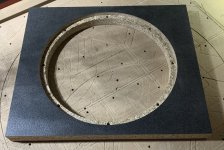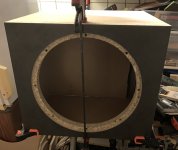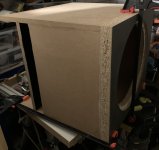While following the very interesting debate about passive OB LF boost, I discovered this article on @perrymarshall 's website: https://audioxpress.com/article/the-dsp-assisted-reflex-system
Basically, it is about a nice EQ trick that allows some LF boost and "subsonic" filter for bass reflex boxes - allowing various design choices. I am especially interested in making an undersized BR box, since that is the only other option besides a sealed box for my smaller listening room.
I tried to make some simulations in Hornresp and using this kind of EQ seems to do what I need for the SPL levels I need. I especially like the excursion control without using a real high order subbas filter.
The article mentions using a shelf filter in MiniDSP (I actually happen to have one), but AFAIK, there is no shelving filter in Hornresp. So I used two peaking filters, one to boost and one to cut plus a first order highpass to approximate the high Q shelf filter. Is that equivalent, or is the shelf filter better in some regard?
I would like to first see in Hornresp what is possible before I start cutting wood, the final filter would be of course based on measurements. Am I on the right track?
The intention is to build a relatively small two way system with a large 400 Hz cutoff horn, the XO will be somewhere around 600 - 900 Hz, which would be good for 12" or maybe even 15" woofer, but there is not much space available for a large box.
Basically, it is about a nice EQ trick that allows some LF boost and "subsonic" filter for bass reflex boxes - allowing various design choices. I am especially interested in making an undersized BR box, since that is the only other option besides a sealed box for my smaller listening room.
I tried to make some simulations in Hornresp and using this kind of EQ seems to do what I need for the SPL levels I need. I especially like the excursion control without using a real high order subbas filter.
The article mentions using a shelf filter in MiniDSP (I actually happen to have one), but AFAIK, there is no shelving filter in Hornresp. So I used two peaking filters, one to boost and one to cut plus a first order highpass to approximate the high Q shelf filter. Is that equivalent, or is the shelf filter better in some regard?
I would like to first see in Hornresp what is possible before I start cutting wood, the final filter would be of course based on measurements. Am I on the right track?
The intention is to build a relatively small two way system with a large 400 Hz cutoff horn, the XO will be somewhere around 600 - 900 Hz, which would be good for 12" or maybe even 15" woofer, but there is not much space available for a large box.
I have just checked and it does - Q adjustable from 0.5 to 2.0. It also does have 4th order with the same Q adjustment range.
Above is a MiniDSP 2x4HD 40Hz shelf filter, -16dB, Q=2.
This curve is VERY similar to a 70Hz 2nd order high pass filter with a Q of 2. Each gives you a peak of +6dB at 70Hz, and they're pretty much identical above 40Hz. They're mostly different below 40, where the shelf has that symmetry you see and the 2nd order just keeps rolling off.
I prefer shelf filters to 2nd order filters because they have less phase shift and you don't need 50dB of protection below system cutoff; 15-20dB is more than enough. Also, MiniDSP doesn't have a Q setting on their 2nd order filters.
I think the 2nd order filter will be close enough for your HornResp modeling. Run your model, then when you bild, play with the DSP shelf until the peaks align. @pelanj
Unless the incoming digital signal is attenuated, aren't you going to get clipping by boosting? Hopefully software reports clipping if this happens. You might particularly see this in tracks with low dynamic range or heavy bass.
This has never been a problem for me. Maybe it's because most of my speakers are high efficiency. If it is, then attenuate the incoming digital signal.
Last edited:
How much headroom do you maintain in your incoming signal? Do you attenuate at all or use max volume i.e 0dB?
I can control the level at the following places:
My phone (which streams through the WiiM)
MiniDSP Master volume control
MiniDSP channel 1-2 Input levels
MiniDSP channels 1-4 output levels
Input attenuators on my amp
Unless I turn the amp way down I never encounter an issue where the MiniDSP clips.
But if you want to ensure the MiniDSP can’t clip, just turn down the input levels to -6 or -10dB.
My phone (which streams through the WiiM)
MiniDSP Master volume control
MiniDSP channel 1-2 Input levels
MiniDSP channels 1-4 output levels
Input attenuators on my amp
Unless I turn the amp way down I never encounter an issue where the MiniDSP clips.
But if you want to ensure the MiniDSP can’t clip, just turn down the input levels to -6 or -10dB.
Fair enough
I suppose anytime I see someone go above 0dB on the signal, then somewhere before in the chain they need to have lowered the signal by that amount or risk clipping. For example reduce the input signal by 3dB before applying a linkwitz transform
I suppose anytime I see someone go above 0dB on the signal, then somewhere before in the chain they need to have lowered the signal by that amount or risk clipping. For example reduce the input signal by 3dB before applying a linkwitz transform
So it seems I have a practical example / test box to build. I have this woofer: https://www.thomann.de/cz/the_box_speaker_122808a.htm Maximum available volume is 75 l including the vent. I ended up with 60 l tuned to 40 Hz, with port area of 200 cm2 (a little more than 1/3 Sd). By applying the EQ, I can get solid 40 Hz at 114 dB with ca 80 W at Xmax, which is already too loud for the room. Or am I way off?


Instead of using the 12", I might actually try 15OB350 in an even smaller box. This is what Hornresp says (50l, tuned to 40 Hz and EQ):

Yeah.
I worked with dsp and after experiencing the degrees of freedom of design you have and the listening experience you gather after some time I wonder how any Hifi enthusiast can live without this mighty tool (should be measurement assisted).
The ear is so receptive to changes. You learn that even "slight" anomalies like a 3db irregularity of a driver at a frequency like 800hz makes an important sonic difference after correction. If you want a neutral sounding speaker.
Of what concerns the subsonic protecting slopes I used the more the better. 48db/octave on minidsp below reflex resonance sounded more clean to me than less db/octave.
I worked with dsp and after experiencing the degrees of freedom of design you have and the listening experience you gather after some time I wonder how any Hifi enthusiast can live without this mighty tool (should be measurement assisted).
The ear is so receptive to changes. You learn that even "slight" anomalies like a 3db irregularity of a driver at a frequency like 800hz makes an important sonic difference after correction. If you want a neutral sounding speaker.
Of what concerns the subsonic protecting slopes I used the more the better. 48db/octave on minidsp below reflex resonance sounded more clean to me than less db/octave.
Yes, DSP is indispensable. It amazes me it’s not more popular. It’s also a lot easier to implement than passive.
When I experimented with 36 and 48dB slopes I found I could hear an audible group delay between the “slap” of a bass drum and the “thump” of the same bass drum. The steeper the slope, the more easily I could hear it.
The solution I landed on was what I believe @pelanj is doing, which is using a simple 2nd order shelf filter with a Q between 2-3, precisely choosing the frequency. I show examples of that here:
https://audioxpress.com/files/attachment/2721
Figure 8 in particular.
You need to cut input below resonance by at least 14dB in the space of 1/2 octave and this kind of filter fits the bill perfectly. It buys you as much as 6-12dB dynamic range in reflex horn or TL by reducing out of band excursion, with much less group delay.
When I experimented with 36 and 48dB slopes I found I could hear an audible group delay between the “slap” of a bass drum and the “thump” of the same bass drum. The steeper the slope, the more easily I could hear it.
The solution I landed on was what I believe @pelanj is doing, which is using a simple 2nd order shelf filter with a Q between 2-3, precisely choosing the frequency. I show examples of that here:
https://audioxpress.com/files/attachment/2721
Figure 8 in particular.
You need to cut input below resonance by at least 14dB in the space of 1/2 octave and this kind of filter fits the bill perfectly. It buys you as much as 6-12dB dynamic range in reflex horn or TL by reducing out of band excursion, with much less group delay.
Last edited:
The test box is now WIP. The front panel is CNC cut from kitchen board leftover, the rest from 18 mm MDF. The 15OB350 is not the best woofer for traditional bass reflex alignments, so I am really curious how this turns out. It seems I should have bass down to 40 Hz with less EQ than with a closed box.
Attachments
A long time ago I made a DSP assisted reflex using the Morel MW1075 10” woofer, which with a Q of 1.06 is a truly strange reflex alignment. Absolutely not suited for reflex under normal conditions. 70 liter box with 12” passive radiator.
Impossible to make work without DSP, as it had a 5dB peak at 65Hz and needed about 6dB boost at the tuning frequency of 30Hz. It worked great with DSP and had great response down to 25Hz. The DSP filtered out frequencies below 25 and excursion was very low. The MW1075 has great midrange and this made for a very good 2-way.
Your 15OB350 situation is very similar; you would never normally use it in a reflex and DSP lets you bend the rules far beyond anything possible with passive.
Impossible to make work without DSP, as it had a 5dB peak at 65Hz and needed about 6dB boost at the tuning frequency of 30Hz. It worked great with DSP and had great response down to 25Hz. The DSP filtered out frequencies below 25 and excursion was very low. The MW1075 has great midrange and this made for a very good 2-way.
Your 15OB350 situation is very similar; you would never normally use it in a reflex and DSP lets you bend the rules far beyond anything possible with passive.
Last edited:
It starts to look like a box. This is the second build using a track saw. I need to practice a bit more, but a track saw is definitely a way to go.
Since it is just a test box, it will get a test finish only. I tried a small roller for the inside black painted panels and it looks better than with a brush.
Since it is just a test box, it will get a test finish only. I tried a small roller for the inside black painted panels and it looks better than with a brush.
Attachments
yeah track saws are really good arnt they . and a much nicer experience than a circular saw spitting up sawdust etc in your face . make for a pretty professional looking result .what cnc are you using please ? that's next on my list of purchases I'd like to get
It is a hobby CNC made by two guys here in CZ. https://lupa-cnc.com/ I have the widened version with 300 W brushless spindle.
I was thinking about buying a table saw - but I think getting a better tracksaw with extra rails/tracks will be more practical and still safer to use.
I was thinking about buying a table saw - but I think getting a better tracksaw with extra rails/tracks will be more practical and still safer to use.
- Home
- Loudspeakers
- Multi-Way
- DSP assisted reflex system


